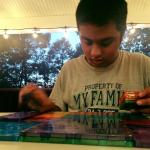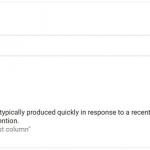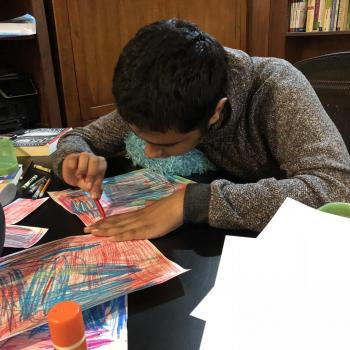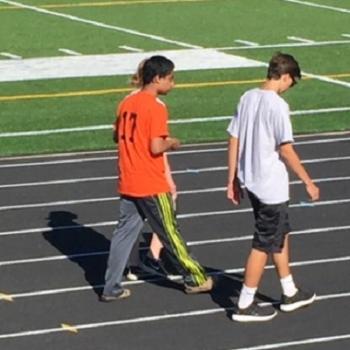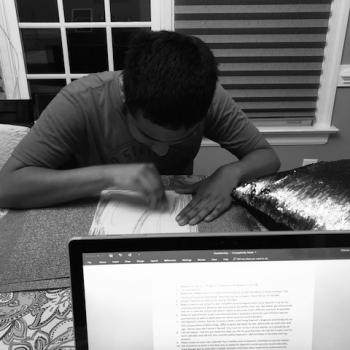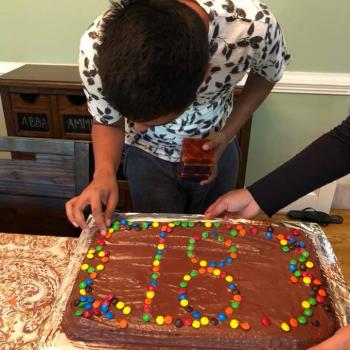I remembered that particular feeling and fear twice. I remembered thinking – this is a real thing. We need to be careful.
The first time was years ago at our local grocery store soon after we had moved from New York City to Virginia. My brother and his family were visiting us in our new home, and I took the kids with me to the grocery store to pick up stuff to make chocolate chip cookies.
I had D, who was about five years old, sitting inside the cart so he wouldn’t run away from me. My brother’s daughter, a little less than two years old, and my daughter, who was two, were sitting in the “car” portion, which was attached to the front of this behemoth grocery cart. At one point, as he was wont to do in those days, D started losing his stuffing in the middle of the baking aisle.
He was screaming and jumping in the cart, pulling at my headscarf. The girls were half giggling, half scared at the spectacle. We were just that – a spectacle, with other shoppers and workers looking at us like we were either an alien species or trouble in their midst. I remember thinking – great. Not only do we stick out because of autism, but my brown skin and this headscarf really makes me stick out.
I remember momentarily fearing that someone was going to call the cops on us – either because I couldn’t help my kid calm down and find his self-control, or because we looked like a scary bunch of “others.”
The second time was more recently – last year on an outing to a local park with a friend and her two sons. As we descended the steps to a walking path in the park, D lost his stuffing again, only this time I was waaaay more cool about it and used to it. I sent my youngest son along with my friend and her boys to walk ahead while I waited things out with D.
He was angry and jumping around with force, getting up in my face with intimidating behavior while stopping just short of aggression. I stood my ground while folks around us eyeballed us and cleared a circle around us, all the while talking softly to D and making sure he stayed safe. Soon enough he found his calm, and we continued walking.
I wasn’t rattled by the meltdown, not much at least. I was more rattled by the fear of how folks may react to us. This time, however, I wasn’t thinking about myself and my headscarf as the attracters of attention, but rather D in his strength, loudness and anger – all couched in his beautiful brown skin.
At age 17, my son D is not a boy anymore. He is a young man in the full physical sense of the word. He is taller than me, has started shaving his rather impressive facial hair (or rather his father or I help him shave) and has the appetite, strength and other features and characteristics of a man.
When you pair his physicalness with how he looks – as a young man of color, a young autistic Muslim man — it is a cause for me to worry. Maybe I’m overthinking this, maybe I’m worried about things that are not there. But I don’t think so.
Just this week a Muslim boy, age six, with Downs Syndrome who is described by his father to be nonverbal, was reported to the police by a substitute teacher, who said he heard Mohammed Suleiman say the words “boom” and “Allah” repeatedly. Said his father,
They claim that he’s a terrorist. This is so stupid, this is discrimination, actually. It’s not implied discrimination, it’s a hundred percent discrimination.
Upon the teacher reporting the boy, the Suleiman family became subjects of a police and social services investigation.
Now, consider these statistics:
According to a report released by the American Journal of Public Health, people with mental or physical disabilities were 13 percent more likely to be arrested as juveniles or young adults then people with no disability.
If you’re black, disability widens the margin of the chance of arrest by 17 percent, according to the report, and more than 55 percent of blacks with disabilities were arrested by 28 years of age.
In this article published by Reuters, Erin J. McCauley, a policy analysis and management doctoral student at Cornell University, said the arrest rate for blacks with disabilities was “horrifyingly high” and arrest rates for people of color with disabilities were very high in general:
Using data from a national survey of nearly 9,000 Americans born between 1980 and 1984, McCauley estimated the cumulative probably of arrest by age 28 for people who considered themselves, or whose parents considered them, disabled. Disabilities ranged from blindness, deafness, missing a body part or having an emotional or learning problem.
Nearly one-third of those surveyed had been arrested by age 28. For those with disabilities, the chances of being arrested rose to 43 percent, but the risk fell disproportionately on young people of color.
Blacks with disabilities were at greatest risk of arrest – nearly double the 28 percent risk of whites with disabilities. More than 46 percent of Hispanics with disabilities could expect to be arrested as children or young adults, the study found.
‘The experience of arrest is very high for people with disabilities, especially people of color with disabilities, and steps need to be taken to ameliorate this,’ McCauley said.
Let’s add some more statistics to this already alarming stack. According to a new report by the FBI, the number of reported hate crimes in 2016 (you know, when Donald J. Trump was elected president) increased by nearly five percent to more than 6,100:
As has long been true, hate crimes based on race were by far the biggest category, with more than half of reported hate crime incidents motivated by race, ethnicity, or ancestry. Among those, nearly half were anti-black crimes, and nearly 10 percent were anti-Latino. About one in five were anti-white, although white people were still much less likely, when accounting for total population, to suffer a hate crime than minority groups.
Hate crimes motivated by religion were the next biggest category, making up more than 20 percent of reported incidents. Jewish and Muslim people were the two most common targets in this category, with nearly 54 percent and more than 24 percent, respectively, of religiously motivated hate crimes committed against them.
Compared to 2015, there were increases in reported hate crimes nearly across the board. Reported anti-Muslim hate crimes rose by nearly 20 percent, anti-white by 17 percent, anti-Latino by 15 percent, and anti-Jewish by 3 percent.
Maybe you can see where my fear, and the fear of so many others who are persons of colors with a disability, or the parent or loved one of a person of color with a disability, stems from.
Because if a six-year-old Muslim boy with Downs Syndrome can be reported for supposedly saying something deemed “terrorism” when his family says he is nonverbal – then how can I not worry?


